In much of Florida, the climate is sub-tropical, with mild winters (but subject to short cold spells) and hot, sunny summers. In these place (Florida), there are numerous flowers, shrubs, trailing vines, and evergreen plants all come together to add beauty to landscapes and gardens. A lot of flowers that thrive in shade or sun are perfectly suited to grow in Florida’s humid and hot climate. Flowers can be challenging to grow if you’re new to the area as the Sunshine State has a very diverse climate.
The northern portion of the state has colder winters and coastal breezes while Central and Southern Florida, on the other hand, have constant humidity and sunshine that can make growing flowers challenging. However, there are several native Florida flowers and non-native options that thrive in these conditions. Regardless of your design style, desired size and form in a flower, you won’t be disappointed in not getting varieties that meet your needs and landscape dreams. Here are some of the common Florida flowers.
- Hartwrightia
- Beach sunflower
- Tarflower
- Black-eyed Susan
- Florida flame azalea
- Blanket flower
- Blazing star
- Carolina jessamine
- Columbine Flower
- Sweet acacia
- Coral bean
- Coral honeysuckle
- Elliott’s aster
- Parrot pitcherplant
- Red Chokeberry
- Eastern purple bladderwort
- Powderpuff mimosa
- Railroad vine
- Carolina cranesbill
- Savannah milkweed
- Georgia aster
- Scarlet sage
- Swamp mallow
- Clustered bushmint
- Showy milkwort
- Inkwood
- Violets
- Florida Sweetheart
- Sunshine Mimosa
- Purple Coneflower
- Skyblue Clustervine
- Scarlet calamint
- Alligator Lilly
- Wood Sage
- Pine-pink
- Carolina yellow-eyed grass
- American white waterlily
- Rabbitbells
- False garlic
- Green antelopehorn
Hartwrightia
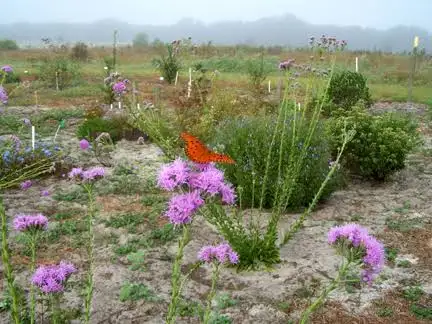
Hartwrightia (Hartwrightia floridana) is an uncommon inconspicuous wildflower found in only 10 Florida and five Georgia counties. It is a state-listed threatened species in both states, where habitat loss and fire suppression imperil it. The plant occurs in seepage slopes, depressions, marsh edges and wet pine flatwoods and prairies. Its pastel flowers bloom in late summer and fall. Pollination has not been studied specifically in Hartwrightia, but it is presumed its flowers are pollinated by the same variety of insects that pollinate other Asteraceae species.
Beech sunflower
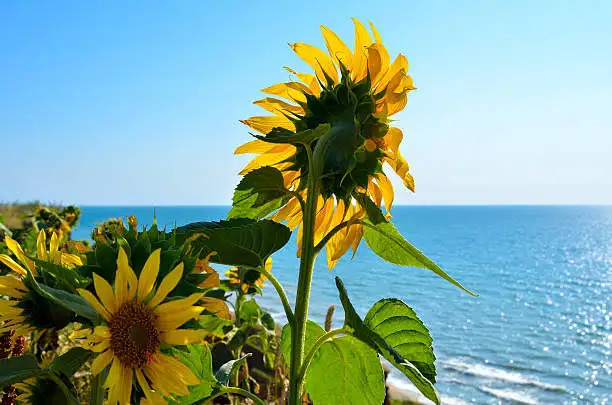
Sunflowers are known for the way the blooms, or flower heads, turn to face the sun throughout the day. The sunflower head is actually composed of hundreds to thousands of individual flowers joined together. Single-stem sunflowers produce one large bloom per plant. This bloom may be followed by multiple smaller flowers. Beach sunflower is the common name for Helianthus debilis, a sunflower species native to coastal Florida. Like common sunflower, it blooms from midsummer through early fall, but it is perennial rather than annual. Yellow blooms appear on its multiple branches and can reach 12 to 24 inches in height with a spread of 36 to 72 inches.
Tarflower
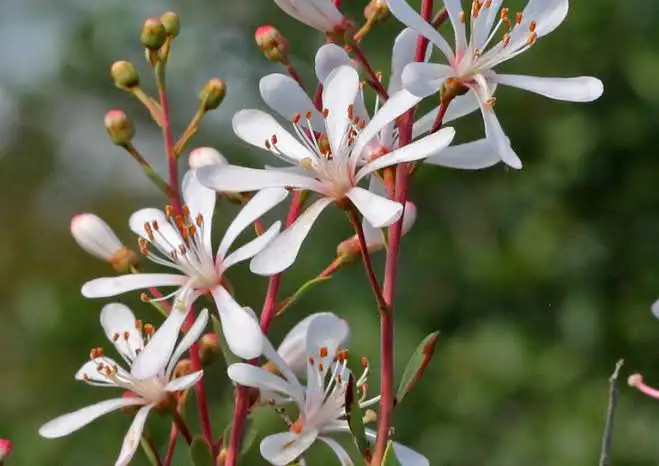
Tarflower (Bejaria racemosa) is a woody evergreen shrub with showy white to pinkish flowers. It occurs naturally in scrub, pine flatwoods and scrubby flatwoods and is found in most of peninsular Florida, but its native range does not extend into the Panhandle. It gets its common name from its sticky flowers that attract and then trap bees, flies and other insects.
Florida flame azalea
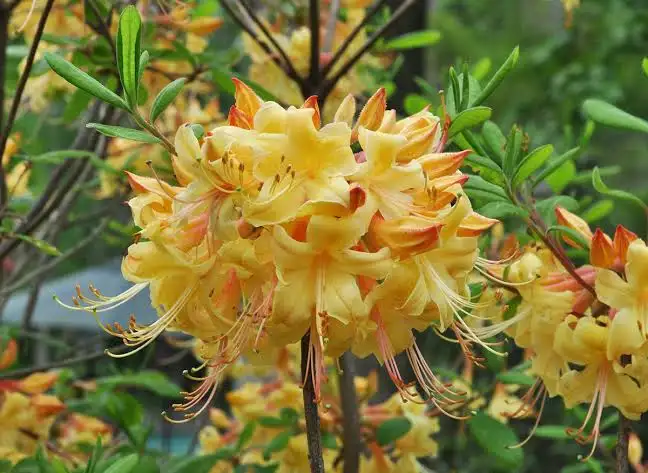
Florida flame azalea (Rhododendron austrinum) is a deciduous flowering shrub found in hardwood, floodplain and slope forests, bluffs and ravines in North Florida. Although easily overlooked most of the year, it puts on a stunning spring display of fragrant fiery flowers. The blooms appear before (or as) the plant leafs out, and attract hummingbirds, butterflies and bees. The plant is a state-listed endangered species.
Blanket Flower
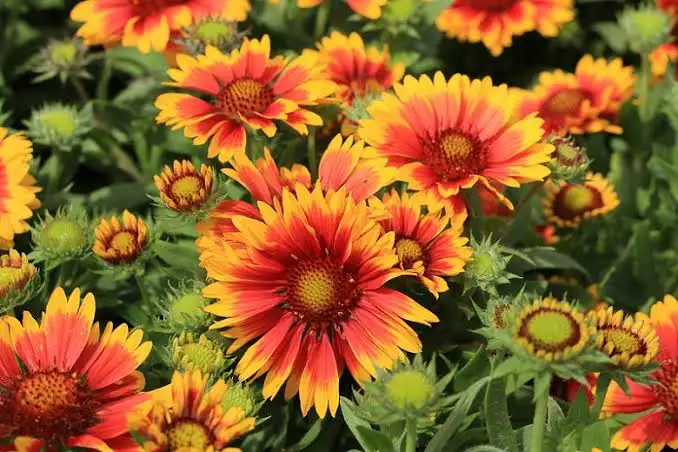
Blanketflower (Gaillardia pulchella), also known as Firewheel and Indian Blanket, is one of two Gaillardia species native to Florida. Blanketflower is an annual or short-lived perennial. Its linear- to lance-shaped leaves are quite hairy, which makes the plant appear grayish-green. Under natural conditions, it’s from 12 to 18 inches tall and about as wide. In gardens, it can easily spread twice that. Its brightly colored flowers, long blooming season and drought tolerance make this a popular garden plant. Flower petals typically are bi-colored with an inner red band surrounded by an outer yellow band. Use Blanketflower in landscape sites where it can be allowed to spread, as it can be a very aggressive re-seeder, especially in loamy soils.
Black eyed Susan

Rudbeckia species are commonly known as Black-eyed Susans or Coneflowers. The most widely available native is Black-eyed Susan (Rudbeckia hirta), found throughout Florida in sandhills, flatwoods and disturbed areas. Black-eyed Susan, especially the variety found in Central and South Florida, appears to be perennial. However, varieties may be annual, biennial or perennial. Plants are generally 1 to 2 feet tall with most of the foliage on the bottom half. Leaves are very rough to the touch (which can help identify young plants). The 3- to 4-inch deep-yellow aster-like flowers have dark brown disk flowers in a central dome. Rudbeckia blooms spring through fall, and has scattered blooms through the winter in South Florida.
Blazing Stars
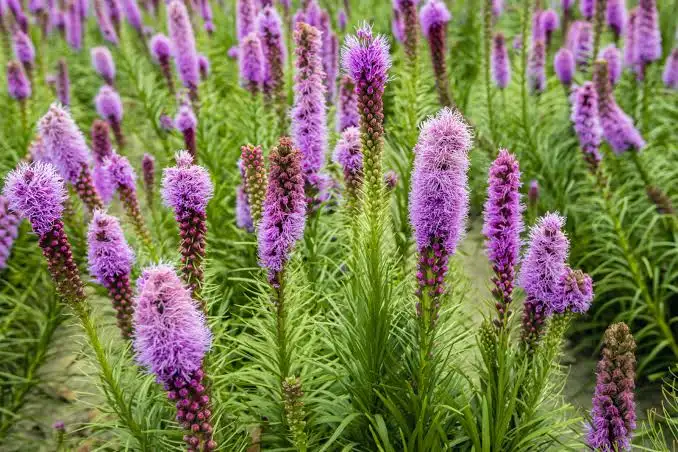
Blazing Stars are taller perennial wildflowers, generally standing 2 to 4 feet. One or more flowering stems rise from basal rosettes in the summer, with blooms appearing anywhere from late summer through fall, depending on the species. This is a deciduous wildflower — it overwinters underground and sends up stalks from thickened, cormlike rootstock, which resembles underground bulbs. Foliage tends to be thin or not particularly noticeable. However, Evergreen Blazing Star does maintain a visible basal rosette in the winter. Blazing Stars are excellent nectar plants and will reliably attract numerous butterflies, moths, bees and other insect pollinators. Flowers start opening at the top of the stem and continue to bloom after cutting.
Sixangle foldwing
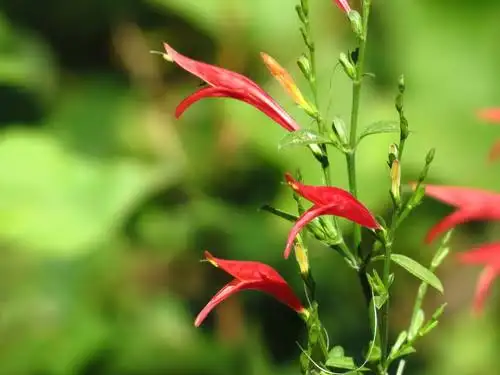
Also known as False mint, Sixangle foldwing (Dicliptera sexangularis) is a modest yet eye-catching wildflower found in coastal hammocks and strands, ruderal areas and mangrove swamps, and along salt marsh edges. It typically flowers spring through early fall, but may bloom year-round. Its bright red blooms are particularly attractive to hummingbirds and butterflies. The plant is a larval host for the Cuban crescent butterfly.
Coreopsis
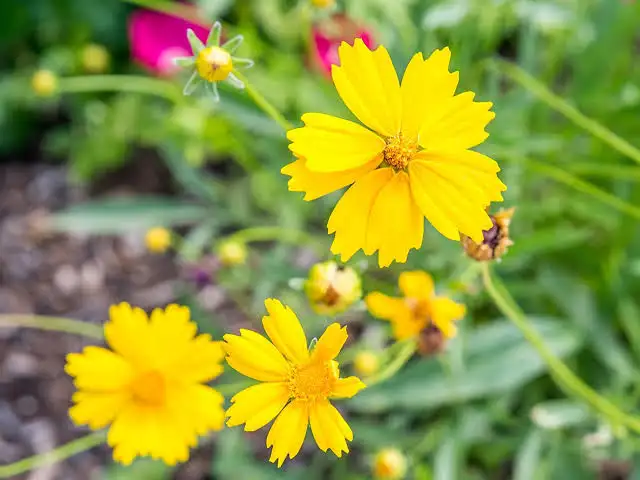
Florida’s state wildflower is Coreopsis, also known as Tickseed, and refers to all 11 species native to Florida. Many of these occur only in North Florida and the Panhandle. Coreopsis is an annual but can be a short-lived perennial in the southern half of Florida. It blooms with bouquets of yellow daisylike flowers throughout the year — especially in spring — when the weather is warm. The 1- to 2-inch flowers have dark centers surrounded by scalloped yellow ray florets, which look like petals, but technically are not. Coreopsis grows 1½ to 3 feet tall on slender stems with many branches. Its bright green leaves are narrow and range from simple to lobed or deeply divided, thus giving the plant a more open appearance.
Seaside Goldenrod
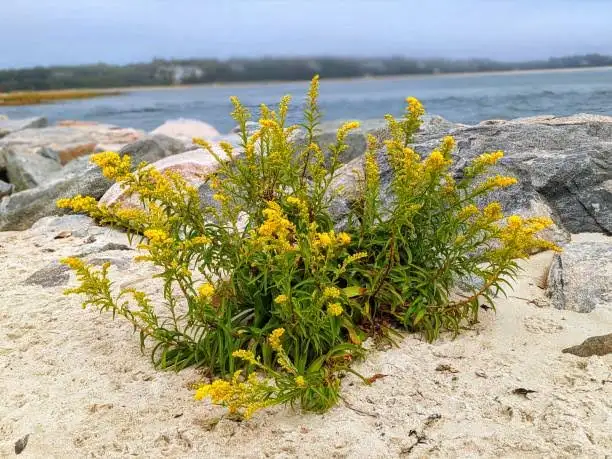
Seaside Goldenrod has goldenyellow tubular blooms that densely cover the long wandlike inflorescences on the tips of the stem in summer and fall in most of the state, and also in the spring in South Florida. This perennial retains long, strap-shaped, somewhat-fleshy basal leaves year-round. Leaves gradually become smaller as they ascend the stems. Plants are 4- to 6-feet tall in flower and spread by rhizomes to make large colonies over time. Plant it where it can make a big show in the garden, or allow it a large space in the landscape. This plant blooms in very showy masses on dunes, in swales and brackish marshes, on sandy soils in coastal areas, and occasionally inland throughout the state.
Spotted Beebalm
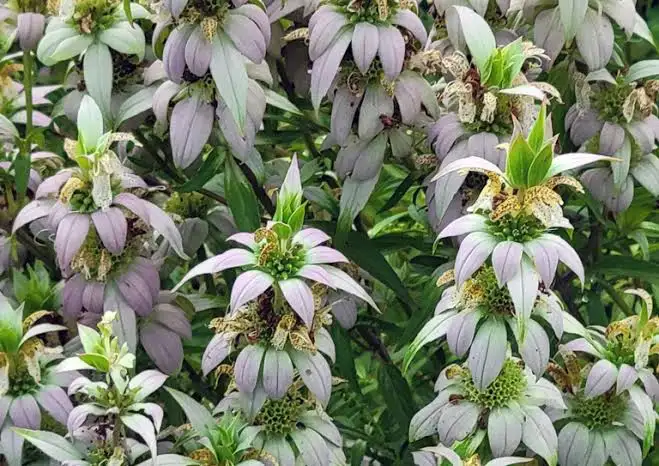
Monarda punctata is a perennial that dies back to the ground in winter in North Florida, but can retain some foliage farther south. It is multi-stemmed, almost bushy in form, with a 2- to 4-foot spread and height of about 3 feet. It can grow taller with irrigation and fertilizer. Its bright green, lanceshaped leaves make attractive foliage that is scented like oregano or thyme. The whorls of flowers are creamy white to yellow with purple spots, and are underlain with even showier bracts of lavender to cream. The whorls are repeated several times on a single stem. Because of its height and ability to spread easily by seed, it should be used toward the back of the landscape or in a place of its own. Commonly found in dry sandy soils that are often disturbed sites, such as roadsides, but also in open pine flatwoods.
Silver-leaved Aster
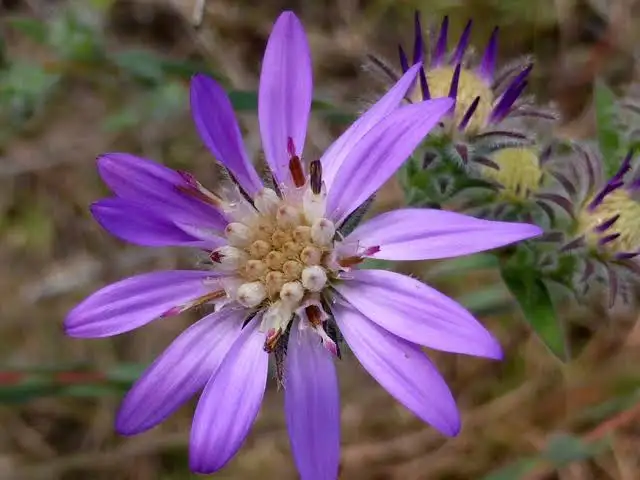
Silver-leaved Aster (Pityopsis graminifolia) also known as Grass-leaved Goldenaster or Narrowleaf Silkgrass, is found throughout Florida in scrub, sandhills and flatwoods ecosystems. Silver-leaved Aster is a fitting name, as the leaves are covered with silky hairs that give it a silvery look. At first glance, the plant may appear to be a grass. It is a perennial with short or long rhizomes, depending on the variety, and is less than a foot tall until the fall, when it sends up bloom stalks on stems up to 3 feet tall. Its yellow aster-like flowers can bloom into November and December, and even later farther south.
Georgia aster
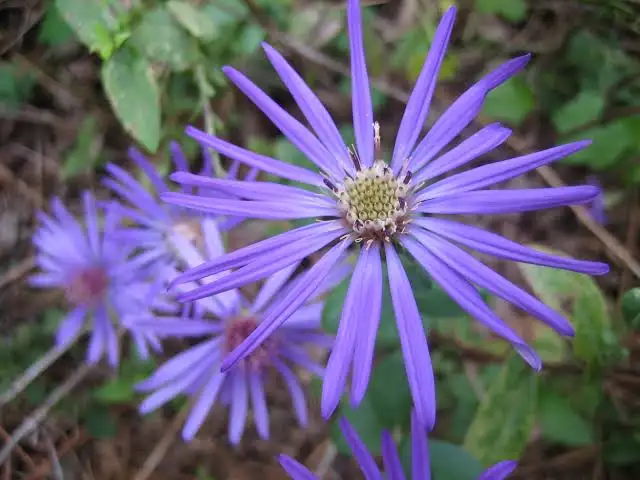
Georgia aster (Symphyotrichum georgianum) blooms in October and November and is a magnet for bees and butterflies. Its flowers are distinguishable from other Symphyotrichum species by their relatively large size (up to 2 inches in diameter) and deep violet-colored ray petals. In Florida, the plant occurs only in Leon County and is a state-listed threatened species. It is also found in a few counties in Alabama, Georgia and North and South Carolina. Habitat loss and fire suppression in its native pineland and savanna ecosystems have contributed significantly to its decline.
Savannah milkweed

With its diminutive stature and greenish-yellow flowers, Savannah milkweed (Asclepias pedicellata) is oft overlooked in its native pineland and prairie habitats. It blooms late spring through fall, peaking in summer. Its flowers are attractive to bees, wasps and butterflies. Like all members of the Asclepias genus, Savannah milkweed is a larval host plant for Monarch, Queen and Soldier butterflies. The plant contains a milky latex that is toxic to most animals, but Monarch, Queen and Soldier caterpillars are adapted to feed on them despite the chemical defense.
Carolina cranesbill
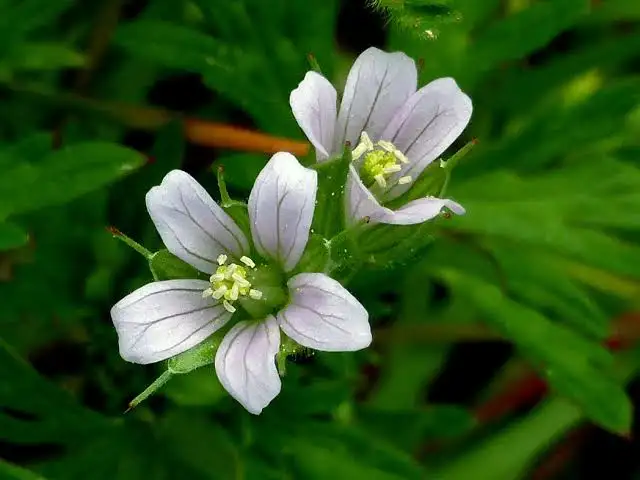
Carolina cranesbill (Geranium carolinianum) is an annual native wildflower that occurs in lawns, urban gardens and disturbed areas throughout Florida. It is often considered a weed, but its winter- and spring-blooming flowers attract bees and other small pollinators. Birds eat the seeds and white-tailed deer may forage on the leaves. Humans can eat the leaves, too, but they can be very bitter and astringent. The root has been used historically to treat sore throats and diarrhea. Carolina cranesbill is Florida’s only native Geranium species.
Starry Silphium
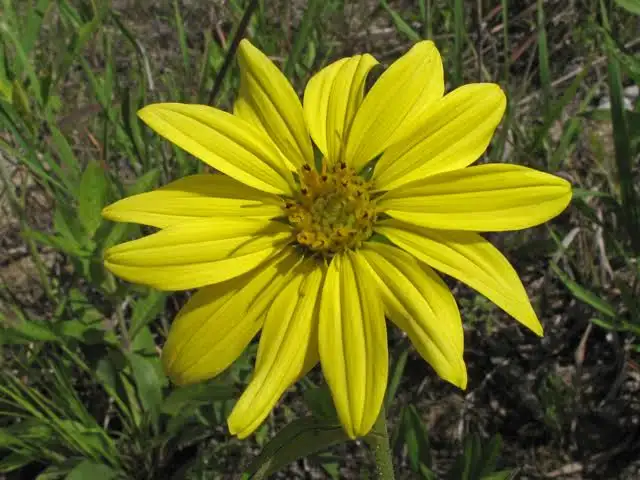
Starry Silphium is a perennial that may die back in the winter, particularly if cold. It sports new foliage in the spring and can produce flowers from mid-spring through early fall, and even through winter if temperatures are mild. The flowering stems can reach 3 to 5 feet, with plants about 2 feet across. The lance-shaped, toothed leaves occur throughout the stem to the flowering scapes, where the stems branch to support many flowering heads. The 2-inch flowerheads have yellow ray petals and disks. This species is especially loved, because it blooms over a long period of time.
Narrow-leaf Sunflower
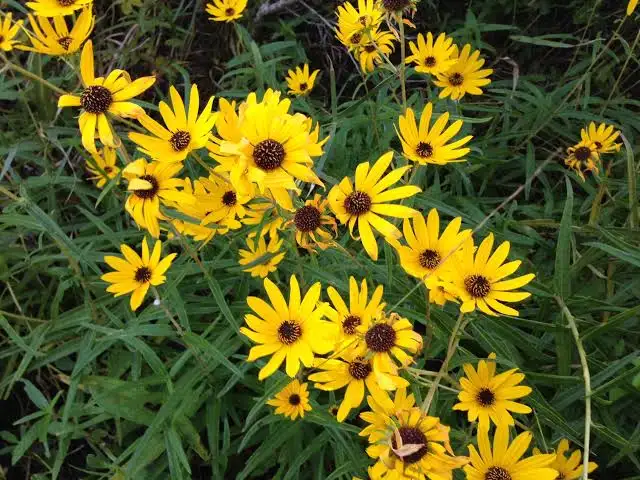
Narrow-leaf Sunflower has showy golden flowers 3 inches across with reddish-brown centers. It can reach 4 to 6 feet in height. It has long, narrow, rough leaves, hence its name. This plant blooms in the fall and is perennial, but may die back to the ground in the winter, particularly in the northern third of the state. It’s a great choice for a large moist meadow, around a lake edge or retention pond, in a ditch or at the back of a bog garden.
Carolina jasmine

Carolina jasmine will grow 12 to 20 feet tall on a wall or trellis and will even climb landscape trees and tall shrubs. Space the plants 4 to 8 feet apart to cover a wall or trellis. Carolina Jessamine vines are covered with clusters of fragrant, yellow flowers in late winter and spring. The flowers are followed by seed capsules that ripen slowly over the remainder of the season. Carolina jessamine is easy to grow. It is attractive on an arbor where the slender branches hung with yellow flowers can be seen from below. This plant will stay in scale and can be used on decks and porches and near patios and entryways. It is good in containers and as a ground cover along steep banks to help control erosion.
Columbine

The columbine plant (Aquilegia) is an easy-to-grow perennial that offers seasonal interest throughout much of the year. It blooms in a variety of colors during spring, which emerge from its attractive dark green foliage that turns maroon-colored in fall. The blooms have spurs: long, narrow strips streaming horizontally from the back of each flower. This plant is generally planted in early spring. Established plants typically bloom for about four weeks starting in mid-spring.
Sweet acacia
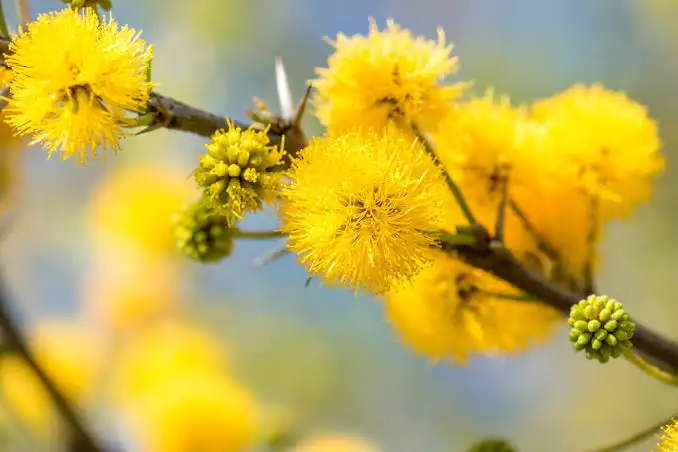
Sweet acacia (Vachellia farnesiana) is an aptly named shrub to small tree with golden, sweet-scented flowers that bloom year-round, peaking in winter. These nectar-rich flowers attract a variety of pollinators, especially butterflies like the Red-banded hairstreak. The plant’s dense foliage provides cover for birds and small animals. Few birds eat the pods. Sweet acacia occurs naturally in pinelands, coastal hammocks and shell middens throughout Central and South Florida, with rare populations in three Panhandle counties. In Europe, the plant is cultivated for use in perfumes.
Coral bean

The coral bean is an attractive and showy with almost year-round interest. The coral bean is adorned with gorgeous ornamental, tubular flowers. In the summer and into the fall, the flowers turn into long pods with brilliant red seeds inside. The foliage of the coral bean is heart-shaped and glossy dark green. The trunk and branches are covered in small curved thorns. The tubular flowers are also highly attractive to hummingbirds drawn to the sweet nectar inside them. The coral bean shrub is easy to grow, grows at a moderate rate, and requires little attention once established. It is attractive and showy with almost year-round interest.
Coral honeysuckle

Also called trumpet honeysuckle, this vine is best known for its bright red, tubular flowers. Clusters of blooms emerge on new growth in spring and summer. The flowers attract hummingbirds and butterflies for months before maturing into berries. These fruits draw songbirds in late summer and fall.
Parrot pitcherplant
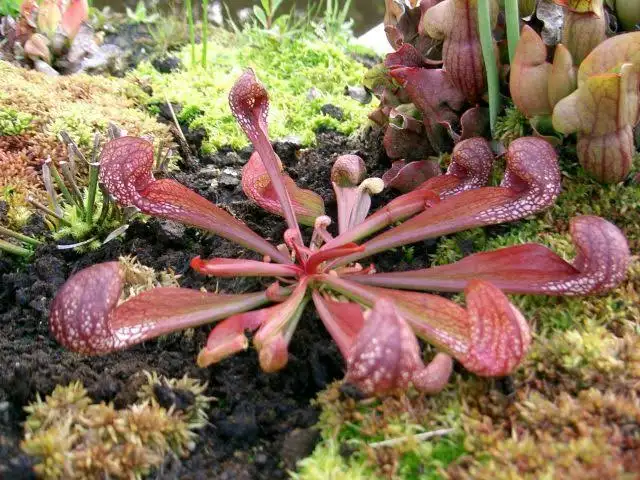
Parrot pitcherplant (Sarracenia psittacina) is a carnivorous perennial plant. It typically flowers in April and May and occurs naturally in seepage slopes, wet prairies, depression marshes, dome swamps, and bogs. Parrot pitcherplant is a state listed threatened species. Its species name psittacina means “of or relating to parrots” and refers to the shape of the flower resembling the head of a parrot.
Red chokeberry
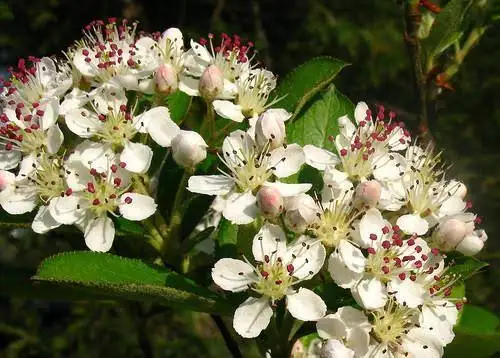
Red chokeberry (Aronia arbutifolia) is a deciduous shrub found in moist to wet pine flatwoods and along wetland and swamp margins. In late winter and spring, the plant is covered in a profusion of showy, sweet-scented blooms that attract a variety of pollinators, especially bees. In summer, flowers give way to a bounty of berries that persist well into fall. Although birds don’t care much for them, they may be eaten by deer, rabbits and other small mammals. Humans can eat them, too, but their taste is bitter and acidic. They are best made into jam, jelly, pie or wine. The fruits are high are in antioxidants.
Eastern purple bladderwort

Eastern purple bladderwort (Utricularia purpurea) is an aquatic carnivorous plant found in wetlands, freshwater swamps and shallow ponds and lakes throughout Florida. Its small but showy lavender flowers bloom year-round. This highly specialized plant feeds on insects and other small organisms caught in its bladder-like trap. Unsuspecting prey brush against tiny hairs that trigger a trapdoor. As the door closes, the organism and water are sucked into the bladder. With the bladder full and the door closed, the plant releases enzymes to digest the organism.
Powderpuff mimosa
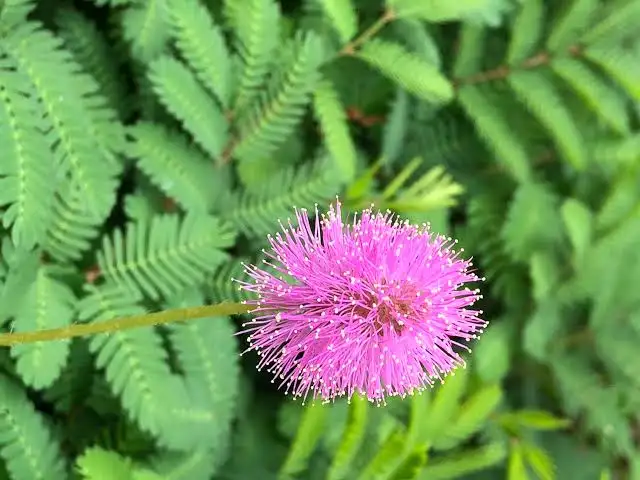
Powderpuff mimosa, also known as sunshine mimosa, is a native, low-growing Florida groundcover that is increasingly being used in home and commercial settings. From spring through fall, this versatile plant blooms non-stop with pink, ball-shaped flowers that look like small powderpuffs. Powderpuff mimosa is an effective ground cover because it spreads very quickly. As few as four or five pots can cover up to 300 square feet in a season. However, it’s not an overly aggressive plant and can be intermixed with turfgrass or other plants.
Railroad vine

Railroad vine is an attractive native plant that makes a great groundcover for coastal gardens. Sometimes called beach morning glory, it has a high tolerance for salty air and sandy soils, and can help prevent erosion around dunes. This sprawling plant puts out low-growing runners covered with leathery green leaves. Easily reaching thirty feet, it’s these long, straight runners give railroad vine its common name. It will need some pruning to stay in bounds. It can bloom at any time of year with pink, trumpet-shaped flowers, but it usually looks its best from May to November. In addition to coastal areas, railroad vine can also be grown inland in sunny, well-drained sites large enough to accommodate its rambling nature.
Scarlet sage

Native to southeastern Brazil and Florida, scarlet sage is a perennial sage species that reputedly grows several meters tall in its tropical mountain habitat. The long spikes of densely packed, tubular, red flowers are perfectly adapted to hummingbird pollination, but honeybees and butterflies also flock to the flowers for their abundant, though dilute, nectar. Scarlet sage is a member of the mint family’s largest genus, Salvia, which contains over 900 species, including culinary sage, used to impart its pungent, resinous aroma to savory dishes.
Swamp mallow
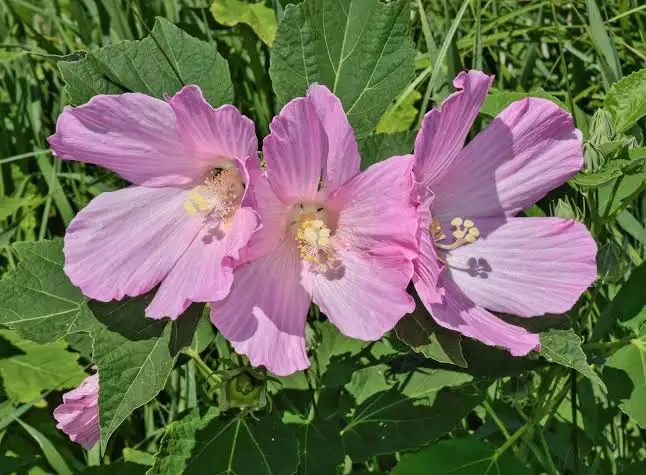
Swamp mallow (Hibiscus moscheutos), also known as rose mallow hibiscus or swamp hibiscus, is a shrubby, moisture loving plant in the hibiscus family that provides big, showy flowers from midsummer to autumn. The solitary blooms are located in the upper leaf axils and are usually white with a crimson center. This species thrives in sunny moist or wet sites where it is sought after by many pollinators. The plant performs well along pond edges or other damp areas.
Clustered bushmint

Clustered bushmint (Hyptis alata) occurs naturally along pond and swamp margins, in moist roadside ditches, and in wet prairies and pinelands. It typically blooms spring through fall, but may bloom year-round. The small flowers attract a variety of pollinators, including bees, butterflies, wasps and occasionally hummingbirds. When crushed, the plant emits a musky fragrance, giving it another common name, Musky mint.
Showy milkwort
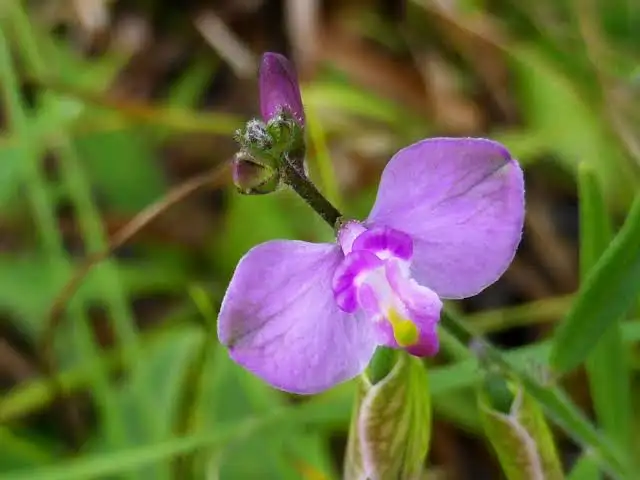
Despite its common name, Showy milkwort (Asemeia violacea) is a diminutive herbaceous wildflower with small flowers that are borne somewhat sparsely on terminal racemes. It is a summer-bloomer, but can bloom year-round in the southern part of the state. The flowers are attractive to bees, the plant’s primary pollinator. Showy milkwort occurs naturally in pinelands, prairies and open disturbed areas throughout Florida.
Violets

Violets typically have heart-shaped or reniform (kidney-shaped), scalloped leaves, though a number have linear or palmate leaves. The simple leaves of plants with either habit are arranged alternately; the acaulescent species produce basal rosettes. Plants always have leaves with stipules that are often leaf-like. The flowers have five sepals that persist after blooming, and in some species the sepals enlarge after blooming. The corolla ranges from white to yellow, orange or various shades of blue and violet or multicolored, often blue and yellow, with or without a yellow throat.
Inkwood
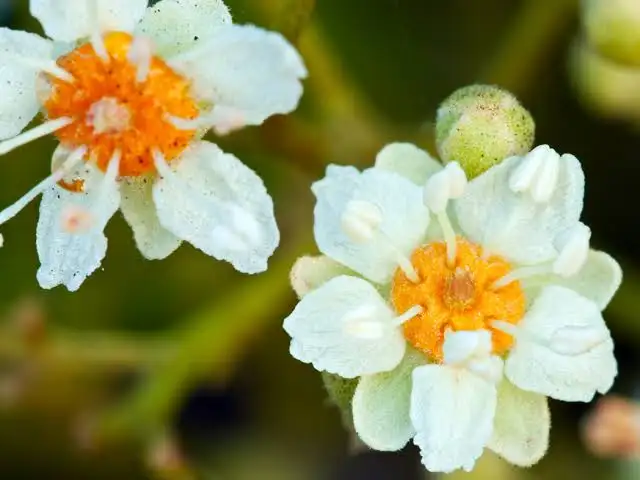
Inkwood (Exothea paniculata) occurs naturally in coastal hammocks, rocklands and shell mounds in coastal Central and South Florida. It is an excellent ornamental option for residential and commercial landscapes. Its dense, evergreen foliage is attractive year-round and offers cover for birds and other wildlife. Its fragrant flowers bloom late winter into summer, peaking in spring. They attract a variety of pollinators. The abundant fruit (produced on female trees) provides a tasty treat for birds in late spring and summer.
Florida Sweetheart

Florida Sweetheart caladiums display red leaves with green edging and the pointed tip of the lance leaf. Florida Sweetheart caladium bulbs produce a smaller plant with short stems and small leaves. Florida Sweetheart is a shade-loving caladium. Caladiums are ideal for container plantings, window boxes and the fronts of perennial borders. Because they are tender plants that don’t handle the cold, many gardeners plant them in pots indoors and then move them outdoors after the danger of pring frost has passed. They also add color and charm to a conservatory or warm sun porch during winter.
Sea lavender
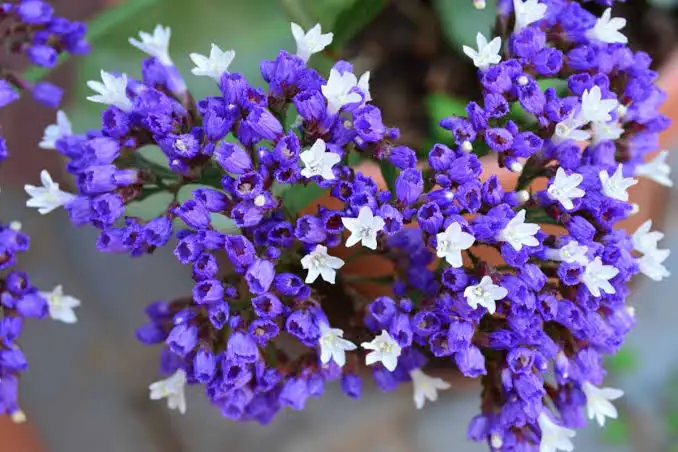
Sea lavender (Heliotropium gnaphalodes) is an evergreen shrub found in dunes and thickets on the Atlantic coast of Central and South Florida. This state-listed endangered species typically blooms in fall and winter, but may bloom year-round. Its small but showy flowers emit a subtly sweet scent and attract many pollinators, especially butterflies. The common name “lavender” likely refers to the plant’s resemblance to true lavender or rosemary. Sea lavender’s leaves have no noticeable scent.
Purple Coneflower
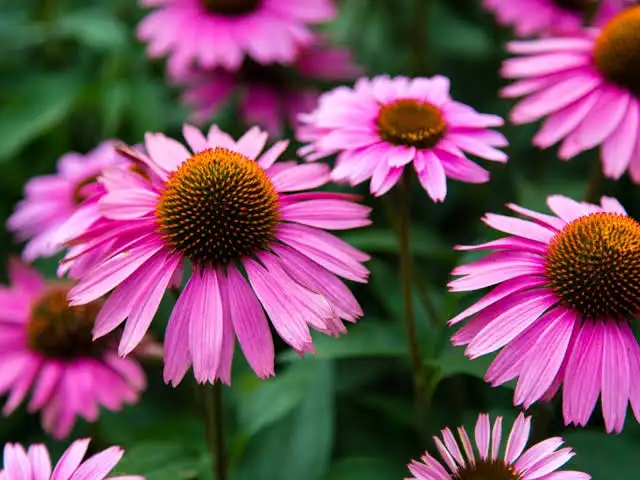
Echinacea is a genus of herbaceous flowering plants in the daisy family. It has ten species, which are commonly called coneflowers. They are found only in eastern and central North America, where they grow in moist to dry prairies and open wooded areas. They have large, showy heads of composite flowers, blooming in summer. The leaf blades in different species may have one, three or five nerves. Some species have linear to lanceolate leaves, and others have elliptic- to ovate-shaped leaves; often the leaves decrease in size as they progress up the stems. Leaf bases gradually increase in width away from the petioles or the bases are rounded to heart shaped.
Skyblue clustervine
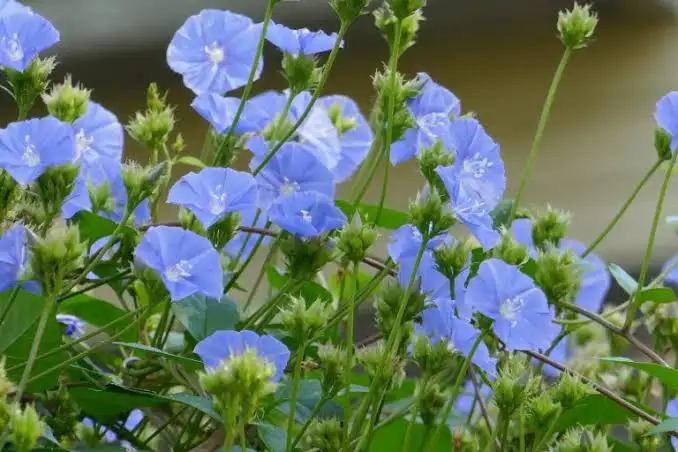
Skyblue clustervine is an evergreen, twining vine that produces many small but showy flowers. Bloom colors range from sky blue to pinkish-lavender, all with white throats. Leaves are deeply veined and oval– to cordate-shaped. Also known as Key West morning-glory or Pineland clustervine, Skyblue clustervine occurs naturally in coastal hammocks and along wetlands in South Florida. It typically flowers in winter, but is known to bloom from early fall through late spring.
Scarlet calamint
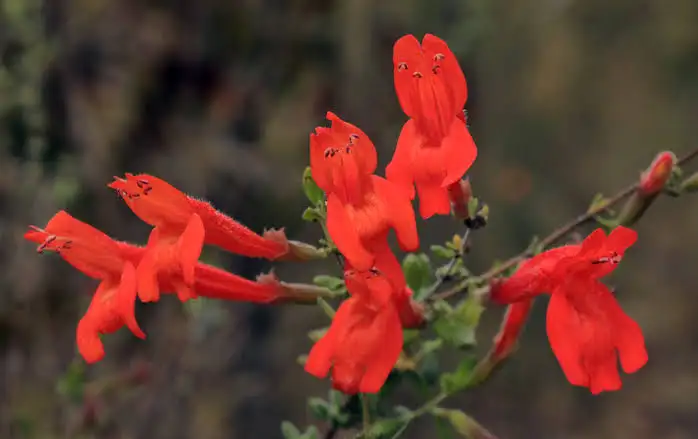
The brilliant red flowers of Scarlet calamint (Calamintha coccinea) offer a dramatic contrast against the backdrop of scrub, sandhill and coastal dunes where the plant naturally occurs. The long, nectar-rich flowers are particularly attractive to hummingbirds and large butterflies. They bloom in abundance in early spring and late fall, but may flower sporadically throughout the year. In peak bloom, a single plant may produce 100 or more flowers.
Alligator lily
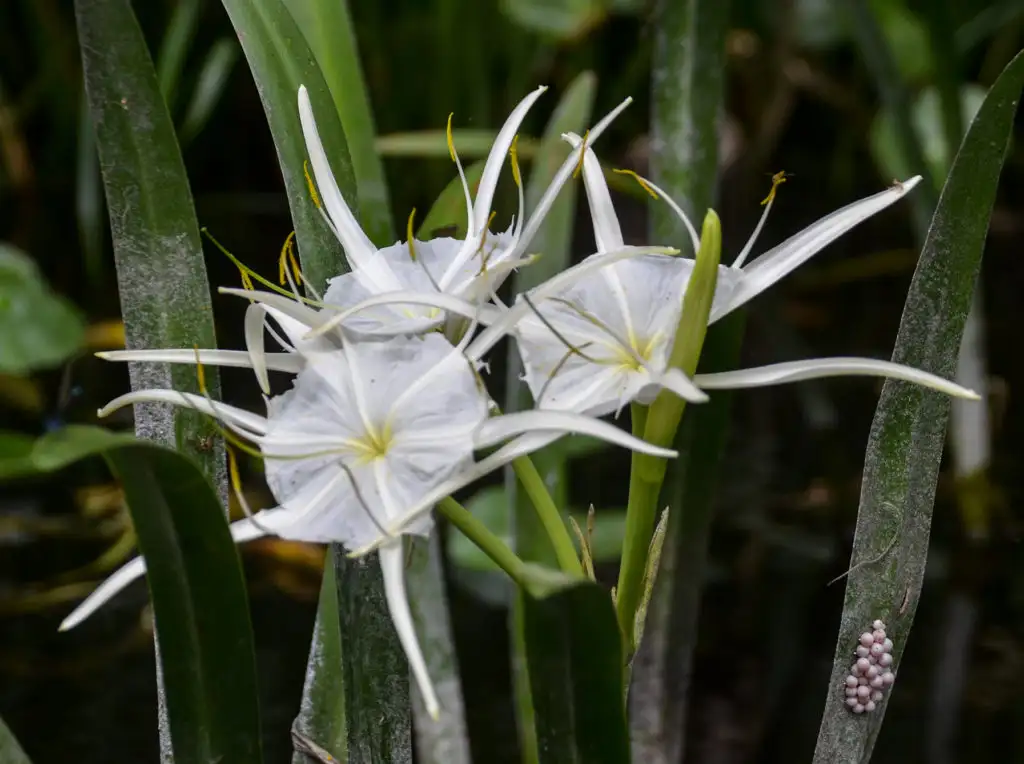
Alligator lily, Hymenocallis palmeri, is a marsh plant that might be as strange as it is beautiful. Also referred to as Spider lilies are sometimes confused with the swamp lily, which has a similar appearance and grows in similar habitats. However, swamp lilies lack the tell-tale staminal cup. Like all members of Hymenocallis, alligator lily arises from a small, onion-like bulb. The leaves are strap-like, long and narrow, and emerge from the bulb in two ranks. Also from the bulb comes a long flower stalk, technically called a scape. The flower is large and showy, white with a greenish yellow center. There are six long, greenish-yellow tepals that extend beyond the staminal cup and six prominent stamen that remind us of the filament in an old-fashion light bulb.
Wood sage

Also known as Canadian germander, Wood sage (Teucrium canadense) is found in floodplains, moist thickets and meadows, marshes and swamps throughout most of Florida. It flowers spring through fall, but may bloom year-round. The flowers attract a variety of native long-tongued insects that will use the flower’s lower lip as a landing pad. Birds find the plant’s seeds appealing.
Pine-pink

Pine-pink (Bletia purpurea) is a state-threatened terrestrial orchid found in swamps, marshes, pinelands and pine rocklands in southern Florida. Its striking pink flowers bloom in winter, spring and early summer. Pine-pink flowers are a food-deceptive species. They do not contain nectar, but may attract bees and other insects with their conspicuous floral display. However, like many orchid species, Pine-pink is self-pollinating, and some of its flowers are cleistogamous, meaning the bud self-pollinates and never fully opens.
Carolina yellow-eyed grass
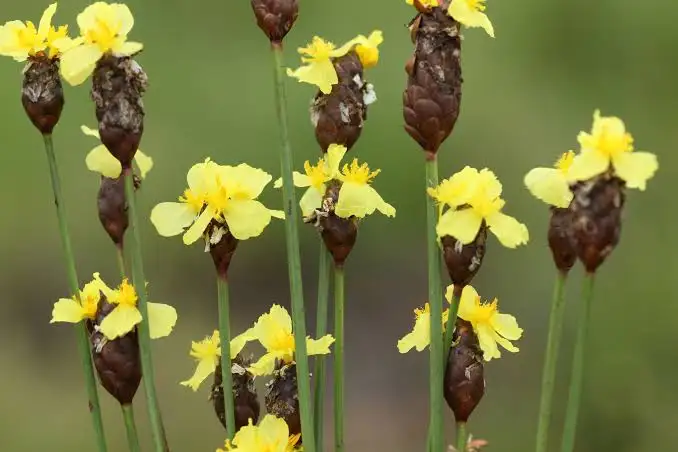
Carolina yellow-eyed grass (Xyris caroliniana) is a perennial wildflower found in pine flatwoods, sandhills, wet prairies, coastal dune swales and bog edges throughout Florida. It blooms late spring through fall and is primarily pollinated by wind and bees, but other insects are known to visit the flowers. Its flowers are relatively small yet conspicuous, and look like pale little butterflies dotting the landscape.
Rabbitbells
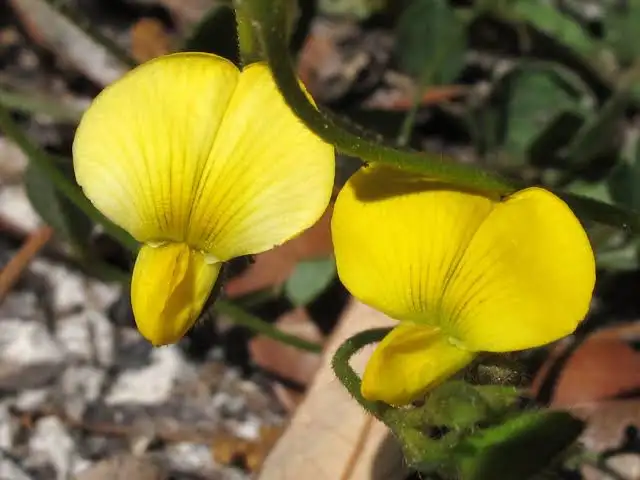
Rabbitbells (Crotalaria rotundifolia) is a low-growing wildflower found in pinelands, sandhills and disturbed sandy areas throughout Florida. Its small yellow flowers bloom throughout the year, attracting mostly bees. The unassuming plant often goes unnoticed as its flowers do not open until the afternoon and remain open only for one day. Of the 15 species of Crotalaria that occur in Florida, only four are native. Rabbitbells is the most common and widespread of the native species.
American white waterlily

American white waterlily (Nymphaea odorata) is a floating aquatic plant. Its large, solitary, fragrant white flowers bloom spring through fall in swamps, marshes, slow-moving streams and shallow lakes, ponds and ditches. The flowers are attractive to butterflies, but they are pollinated primarily by beetles. The plant is also known as Fragrant waterlily.
False garlic

False garlic (Nothoscordum bivalve) is a grasslike perennial with lovely star-shaped flowers. It typically blooms late winter through spring, but may bloom again in or continue blooming into fall. The unscented flowers attract a variety of pollinators, including small butterflies and native bees. The plant occurs naturally in moist woodlands and grasslands and along roadsides in North and Central Florida.
Green antelopehorn

Green antelopehorn (Asclepias viridis) is an herbaceous perennial wildflower found in pinelands, pine rocklands and disturbed areas in a few Florida counties. It flowers winter through summer, with peak blooms in spring. Like many members of the milkweed family, Green antelopehorn is a larval host plant for Monarch, Queen and Soldier butterflies. Their caterpillars have adapted to feed on the plant, which contains a milky latex that is toxic to most animals. The flowers are also an important nectar source for bees and wasps.